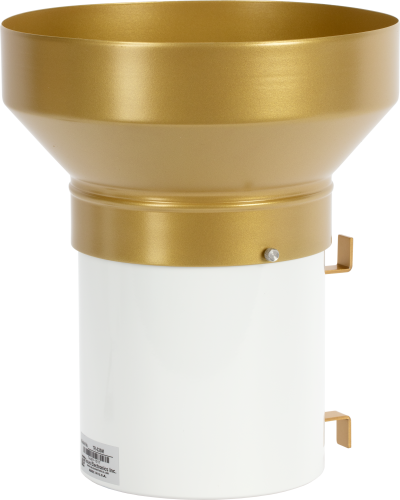
Overview
The TE525MM, manufactured by Texas Electronics, is a tipping-bucket rain gauge that monitors rainfall in metric rather than US units. It measures in 0.1 mm increments and has a 24.5 cm funnel. This tipping bucket is compatible with all Campbell Scientific dataloggers, and is widely used in environmental monitoring applications.
Read More
Benefits and Features
- Accuracy is ±1 percent at rates up to 1 in./hr
- Compatible with most Campbell Scientific data loggers
- High precision—tips at 0.1-mm increments
- Compatible with the CWS900-series interfaces, allowing it to be used in a wireless sensor network
- Includes a 24.5-cm funnel, which is the largest diameter funnel of the TE525-series raingages
The "-L" on a product model indicates that the cable length is specified at the time of order.
Images

Detailed Description
The TE525MM funnels precipitation into a bucket mechanism that tips when filled to its calibrated level. A magnet attached to the tipping mechanism actuates a switch as the bucket tips. The momentary switch closure is counted by the pulse-counting circuitry of our data loggers.
Compatibility
Please note: The following shows notable compatibility information. It is not a comprehensive list of all compatible products.
Dataloggers
| Product | Compatible | Note |
|---|---|---|
| CR1000 (retired) | ||
| CR1000X (retired) | ||
| CR3000 (retired) | ||
| CR6 | ||
| CR800 (retired) | ||
| CR850 (retired) | ||
| CR850 (retired) |
Additional Compatibility Information
Mounting
The TE525MM rain gage mounts to a CM300-series Mounting Pole or a user-supplied 1.5” IPS pole. Several pedestal options are available to secure a CM300-series pole to the ground (see Ordering Information). Accurate measurements require the gage to be level.
Snowfall Adapter
The TE525MM cannot be directly used with our CS705 rainfall adapter. However, the CS705 is compatible with the TE525WS, and the TE525MM can be converted to a TE525WS by returning it to Campbell Scientific (requires an RMA).
Wind Screen
Campbell Scientific offers the 260-953 Wind Screen to help minimize the affect of wind on the rain measurements. This wind screen consists of 32 leaves that hang freely and swing as the wind moves past them.
Specifications
| Sensor Type | Tipping bucket with magnetic reed switch |
| Material | Anodized aluminum |
| Operating Temperature Range | 0° to 50°C |
| Resolution | 1 tip |
| Volume per Tip | 4.73 ml/tip (0.16 fl. oz/tip) |
| Rainfall per Tip | 0.1 mm (0.004 in.) |
| Measurement Uncertainty | 1.0% up to 50 mm/h (2 in./h) |
| Cable Type | 2-conductor shielded |
| Orifice Diameter | 24.5 cm (9.66 in.) |
| Height | 29.21 cm (11.5 in.) |
| Cable Weight | 0.1 kg (0.2 lb) per 3.05 m (10 ft) length |
| Tipping Bucket Weight | 1.1 kg (2.4 lb) |
Documents
Frequently Asked Questions
Number of FAQs related to TE525MM-L: 15
Expand AllCollapse All
-
The TE525MM-L has a 0.1 mm tip.
-
Replacement screens and funnels can be ordered by calling Campbell Scientific.
-
At high-intensity rainfalls, it is likely that the rain will keep pouring into the tipper mechanism while it is tipping, so it will essentially splash out and not be registered. In those instances, there are less tips of the bucket—thus the -3% and -5% listed in the specifications.
-
The CS705 Tipping Bucket Snowfall Adapter cannot be used directly with the TE525-L or TE525MM-L because of the funnel size. To make the rain gages compatible, they can either be sent to Campbell Scientific to be converted to a TE525WS-L, or an 8 inch funnel can be installed. If the funnel is used, see the instruction manual for the appropriate multipliers, as they will change.
-
A TE525-L can be converted to a TE525MM-L and vice versa because the inner tipping mechanisms are the same. To convert a TE525-L or TE525MM-L to a TE525WS-L, the rain gage must be sent in to Campbell Scientific to change the tipping mechanism. If an 8 inch funnel is used on a TE525-L or TE525MM-L without changing the tipping mechanism, the multipliers for the rain measurement will change. For information about these multipliers, see the TE525 Instruction Manual.
-
Not enough tips or too many tips.
-
To incorporate a sensor that is compatible with wireless sensor interfaces into a wireless network, a CWS900-series wireless sensor interface is needed, as well as an A205 CWS-to-PC interface to configure it.
-
The 260-953 Alter-type rain gage wind screen consists of 32 heavy metal leaves that hang freely and swing as the wind moves past them. The swinging leaves act as a wind damper and help minimize the effect of wind on the rain measurements without adding additional turbulence.
-
The most common errors are either that the rain gage appears to have drifted out of calibration or that the tips are not being correctly recorded by the data logger.
-
When a rain gage is out of calibration, it is usually because of the buildup of dirt and grime on the internal surfaces of the tipping bucket mechanism. Cleaning the internal surfaces usually brings the rain gage back into calibration. It is also possible that a rain gage is out of calibration because it is no longer level.
To minimize the possible occurrence of calibration errors, perform routine cleaning and maintenance of the rain gage at least once every three months. The environmental conditions at a particular site may require a facility to perform cleaning, leveling, and maintenance on a much more frequent schedule.
Case Studies
In 1922, when the intact tomb of Tutankhamen was discovered in Egypt's Valley of the......read more
Privacy Policy Update
We've updated our privacy policy. Learn More
